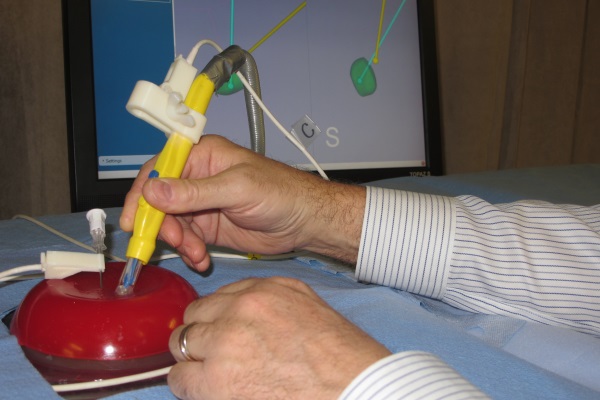Charting new path for breast cancer surgery
December 21, 2015
Share
A new electromagnetic (EM) navigation directed process for removing breast cancer tumours will help oncology surgeons remove the tumour completely the first time with a minimal amount of tissue, according to Queen’s researchers.

Currently, up to 50 per cent of breast cancer surgeries have a “positive margin,” meaning that the surgeon came too close to the tumour when cutting it out. This often leads to a second surgery to remove all of the cancerous tissue, which causes emotional stress to the patient, often leads to poor cosmetic results and ties up operating room time.
“This new process is like the GPS system in your car,” says Jay Engel, head of surgical oncology at Queen’s. “The program eliminates the guesswork and ensures the surgeon removes the right amount of tissue.”
Using the current state of the art technique the radiologist uses an ultrasound machine to locate the tumor and then places a needle with a hook wire into the tumour to localize it. Using the new technique electromagnetic sensors are attached to both the needle and the cautery unit, which is used to remove the tumour, and track these devices in space. Using a sterile computer tablet, the surgeon or radiologist can mark out the desired margin around the tumor and the computer then generates a three dimensional image of the virtual margin that the surgeon uses as a guide for removal. If the cautery unit breaches the virtual margin around the tumour, an alarm sounds.

The EM navigation technology was developed in the Queen’s Laboratory for Percutaneous Surgery (Perk) by director Gabor Fichtinger (School of Computing) and his team.
“This is going to help us get it right the first time,” says Dr. Engel. “Dr. Fichtinger is a world-leader in this technology and, thanks to his team’s expertise, we’re going to be able to remove breast cancer tumours more efficiently.”
The technology has been tested on gel models and on patients with palpable tumours (easy to feel through the skin). In the New Year, Dr. Engel will begin trials on patients with non-palpable tumours (difficult to detect under the skin). According to Dr. Engel, the technology will have the greatest impact on the treatment of non-palpable tumours, which are the most difficult to locate and remove with clear margins.